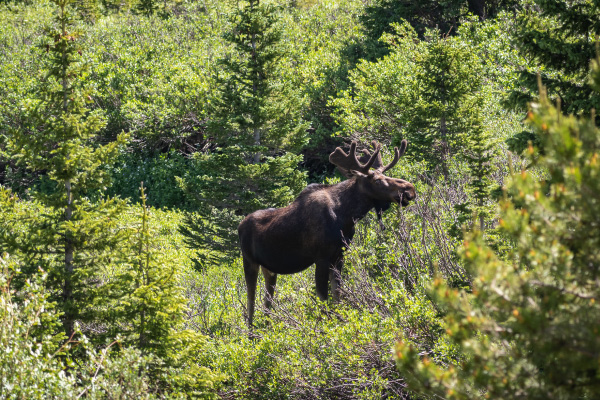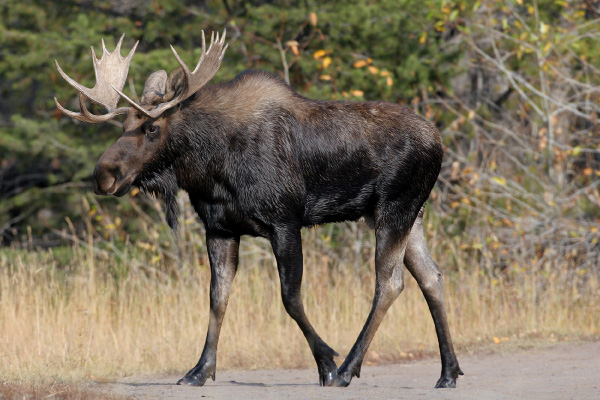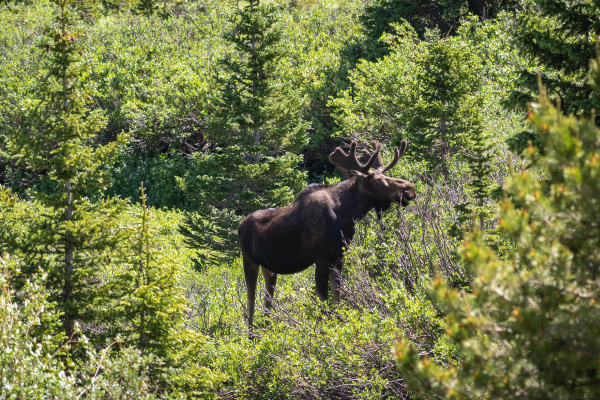¡La temporada de apareamiento de los alces finalmente está aquí
Josue Gonzalez Velez

 Mientras que el clima en las montañas se está enfriando, las cosas se están calentando para los gigantes de la familia de los ciervos: los alces. En septiembre y octubre, el bramido de un alce macho se puede escuchar a kilómetros de distancia mientras buscan febrilmente parejas. El otoño es un momento crucial para estos animales residentes. Si los adultos no se aparean lo suficientemente temprano, su descendencia puede nacer demasiado tarde en la primavera y no estar en condiciones de sobrevivir el invierno siguiente. De hecho, el apareamiento es tan importante que Bull Moose deja de comer durante semanas durante la rutina. En cambio, concentran todo su tiempo y energía en encontrar pareja. Es fácil admirar su dedicación a las citas, pero ¿cómo se las arreglan para encontrar pareja? Los machos de Bull Moose tienen una forma obvia de lucirse ante las damas: sus astas. Cuanto más grande sea el potro, más en forma estará el toro y es probable que haya más hembras interesadas. Resulta que el tamaño sí importa para una hembra de alce, porque un gran conjunto de astas indica que un toro está sano y probablemente engendrará terneros fuertes. Debido a su tamaño y peso, las astas crecen únicamente con fines de apareamiento y luego se caen en el invierno. Los machos de alce comienzan a tener astas después de su primer año, pero es muy poco probable que encuentren una pareja a esta edad temprana. Los alces de vaca tienden a preferir más toros maduros, y la edad máxima de un alce para el apareamiento es entre cinco y diez años.
Mientras que el clima en las montañas se está enfriando, las cosas se están calentando para los gigantes de la familia de los ciervos: los alces. En septiembre y octubre, el bramido de un alce macho se puede escuchar a kilómetros de distancia mientras buscan febrilmente parejas. El otoño es un momento crucial para estos animales residentes. Si los adultos no se aparean lo suficientemente temprano, su descendencia puede nacer demasiado tarde en la primavera y no estar en condiciones de sobrevivir el invierno siguiente. De hecho, el apareamiento es tan importante que Bull Moose deja de comer durante semanas durante la rutina. En cambio, concentran todo su tiempo y energía en encontrar pareja. Es fácil admirar su dedicación a las citas, pero ¿cómo se las arreglan para encontrar pareja? Los machos de Bull Moose tienen una forma obvia de lucirse ante las damas: sus astas. Cuanto más grande sea el potro, más en forma estará el toro y es probable que haya más hembras interesadas. Resulta que el tamaño sí importa para una hembra de alce, porque un gran conjunto de astas indica que un toro está sano y probablemente engendrará terneros fuertes. Debido a su tamaño y peso, las astas crecen únicamente con fines de apareamiento y luego se caen en el invierno. Los machos de alce comienzan a tener astas después de su primer año, pero es muy poco probable que encuentren una pareja a esta edad temprana. Los alces de vaca tienden a preferir más toros maduros, y la edad máxima de un alce para el apareamiento es entre cinco y diez años.
Durante la rutina, no es raro ver cornamentas chocando y enfrentamientos audaces cuando los alces compiten por parejas. Aunque estas exhibiciones son intimidantes, el combate es una buena forma para que los alces evalúen su fuerza en comparación con otros toros y eviten más peleas serias. Al principio de la temporada de apareamiento, estas peleas son similares a los combates de lucha libre en los que es probable que ninguna de las partes resulte herida. Posteriormente, es más común que ocurran peleas severas. Cuando se trata de un empujón, la mayoría de los alces evitarán lesiones graves y retrocederá de un combate de combate cuando su oponente sea claramente más fuerte. 
Más allá de las majestuosas cornamentas, el combate feroz y los bramidos inquietantes, los alces toro tienen otra técnica inusual para atraer a las hembras. Aunque picante y desagradable para las personas, la orina de alce es un afrodisíaco poderoso para las vacas. Los alces machos usan sus astas para cavar hoyos en el barro llamados revolcaderos. Llenan estos pozos de barro con su propia orina y se frotan la mezcla fangosa como una especie de colonia maloliente. El olor del revólver le indica a las hembras de la zona que un macho cercano está soltero y listo para mezclarse. El aroma de un revolcadero es tan atractivo que incluso se sabe que las vacas se pelean entre sí por el derecho a revolcarse.
Rutting es un espectáculo increíble para observar, y el mejor momento para ver el comportamiento de apareamiento de los alces es al amanecer o al anochecer en áreas pantanosas. Piney Lake es conocido como un hotspot para los alces alrededor del Eagle Valley debido a su abundante material leñoso. A veces, los alces también se pueden ver en áreas ribereñas cerca de Minturn en senderos que incluyen Grouse Lake y Cross Creek Trail. Si tiene la suerte de escuchar el bramido de un toro o presenciar un combate, es aconsejable observar desde la distancia. Dale al alce suficiente espacio y privacidad para hacer sus negocios y evita molestar a un alce enojado en una misión como compañero.
Referencias:
Moose, gigante del bosque del norte por: Bill Silliker, Jr.
En compañía de Moose por: Victor Van Ballenberghe
Rachel es la Coordinadora de Programas Comunitarios en Walking Mountains Science Center. Este otoño puede verla disfrutando del clima más fresco y con la esperanza de echar un vistazo a la vida silvestre.
 While weather in the mountains is getting cooler, things are heating up for the giants of the deer family: moose. In September and October, a bull moose’s bellows can be heard for miles as they search feverishly for mates. Fall is a crucial time for these resident animals. If adults don’t mate early enough, their offspring may be born too late in the spring, and be unfit to survive come the following winter. In fact, mating is so important that Bull Moose stop eating for weeks during the rut. Instead, they focus all their time and energy into finding a partner. It’s easy to admire their dedication to dating, but how do they actually go about finding a mate?
While weather in the mountains is getting cooler, things are heating up for the giants of the deer family: moose. In September and October, a bull moose’s bellows can be heard for miles as they search feverishly for mates. Fall is a crucial time for these resident animals. If adults don’t mate early enough, their offspring may be born too late in the spring, and be unfit to survive come the following winter. In fact, mating is so important that Bull Moose stop eating for weeks during the rut. Instead, they focus all their time and energy into finding a partner. It’s easy to admire their dedication to dating, but how do they actually go about finding a mate?
Male Bull Moose have one obvious way they show off to the ladies: their antlers. The bigger the rack, the fitter the bull, and the more females are likely to be interested. It turns out size does matter to a female moose, because a large set of antlers indicates that a bull is healthy and would likely father strong calves. Due to their size and weight, antlers grow solely for mating purposes, then fall off in the winter. Male moose begin growing antlers after their first year, but are very unlikely to find a mate at this young age. Cow moose tend to prefer more mature bulls, and a bull moose’s prime age for mating is between five and ten years.
During the rut it is not uncommon to see clashing antlers and bold stand-offs as bull moose compete for mates. Although these displays are intimidating, sparring is a good way for moose to assess their strength compared to other bulls and avoid more serious fights. Early in the mating season these scuffles are similar to wrestling matches where neither party is likely to be hurt. Later on, it is more common for severe fights to occur. When push comes to shove, most moose will avoid serious injury and back down from a sparring match when their opponent is clearly stronger. 
Beyond majestic antlers, fierce sparring and haunting bellows, bull moose have another unusual technique to attract females. Though pungent and unappealing to people, bull moose urine is a powerful aphrodisiac to cows. Male moose use their antlers to dig pits in the mud called wallows. They fill these mud pits with their own urine and rub the muddy mixture on themselves as a sort of stinky cologne. The wallow’s scent signals to any females in the area that a nearby male is single and ready to mingle. The scent of a wallow is so appealing that cows have even been known to fight each other over rights to a wallow.
Rutting is an incredible spectacle to observe, and the best time to see moose mating behavior is at dawn or dusk in marshy areas. Piney Lake is known as a moose hotspot around the Eagle Valley because of its plentiful woody material. Moose can also sometimes be seen in riparian areas near Minturn on trails including Grouse Lake and Cross Creek Trail. If you are lucky enough to hear the bellow of a bull or witness sparring, it is wise to observe from a distance. Give the moose plenty of space and privacy to do their business, and avoid disturbing an angry bull moose on a mission for a mate.
References:
Moose, Giant of the Northern Forest by: Bill Silliker, Jr.
In the Company of Moose by: Victor Van Ballenberghe
Rachel Dorencz is a community programs coordinator at Walking Mountains Science Center. This fall you can catch her enjoying the cooler weather and hoping to catch a glimpse of wildlife.
Josue Gonzalez Velez
Blog posts
Related Articles.

EVOM
Descubre los Beneficios de los Juegos Mentales Diarios
En la vida diaria, enfrentamos numerosos desafíos que requieren agilidad mental y concentración....

